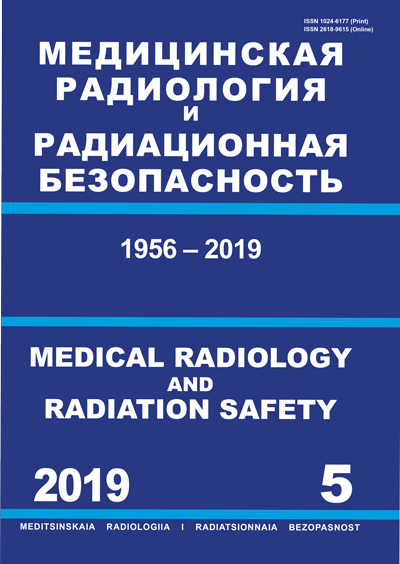Moscow, Russian Federation
Moscow, Russian Federation
GRNTI 76.03 Медико-биологические дисциплины
GRNTI 76.33 Гигиена и эпидемиология
OKSO 14.04.02 Ядерные физика и технологии
OKSO 31.06.2001 Клиническая медицина
OKSO 31.08.08 Радиология
OKSO 32.08.12 Эпидемиология
BBK 51 Социальная гигиена и организация здравоохранения. Гигиена. Эпидемиология
BBK 534 Общая диагностика
TBK 5708 Гигиена и санитария. Эпидемиология. Медицинская экология
TBK 5712 Медицинская биология. Гистология
TBK 5734 Медицинская радиология и рентгенология
TBK 6212 Радиоактивные элементы и изотопы. Радиохимия
Purpose: To study the binary possibility of using the available linear electron accelerators for the neutron therapy and radioisotopes production. For both applications, calculations were performed and the results were normalized to the characteristics of the Mevex accelerator (average electron current 4 mA at a monoenergetic electron beam 35 MeV). It turns out that the production of both photoneutrons and radioisotopes is effective when using bremsstrahlung radiation generated in the giant dipole resonance of a heavy metal target. Material and methods: The unifying problem for both applications is the task of target cooling: at beam power ~ 140 kW, half of it or more is deposited directly in the target. Therefore the liquid heavy metal was selected as a target, in order to conjoin high thermohydraulics quality with maximal productivity both bremsstrahlung radiation and photoneutrons. The targets were optimized using precise codes for radiation transport and thermohydraulics problems. The optimization was also carried out for the installations as a whole: 1) for the composition of the material and configuration of the photoneutron extraction unit for neutron capture therapy (NCT) and 2) for the scheme of bremsstrahlung generation for radioisotopes production. Results: The photoneutron block provides an acceptable beam quality for NCT with a high neutron flux density at the output ~2·1010 cm–2s–1, which is an order of magnitude higher than the values at the output of the reactor beams that worked in the past and are currently being designed for neutron capture therapy. As for radioisotopes production, using optimal reaction channel (γ, n) 43 radioisotopes in 5 groups were received. For example, by the Mo100(γ,n)99Mo reaction the precursor 99Mo of main diagnostic nuclide 99mTc with specific activity ~6 Ci/g and total activity of the target 1.8 kCi could be produced after 1 day irradiation exposure. Conclusion: The proposed schemes of neutron and bremsstrahlung generation and extraction have a number of obvious advantages over traditional techniques: a) the applying of the electron accelerators for neutron production is much safer and cheaper than to use conventional reactor beams; b) accelerator with the target, the beam output unit with the necessary equipment and tooling can be placed on the territory of the clinic without any problems; c) the proposed target for NCT is liquid gallium, which also serves as a coolant; it is an “environmentally friendly” material, its activation is rather low and rapidly (in ~4 days) falls to the background level.
industrial electron accelerator, bremsstrahlung, photoneutrons, neutron capture therapy, radioisotopes for medicine
1. Kostromin SA, Syresin EM. Trends in accelerator technology for hadron therapy. Pis’ma v ECHAYA. 2013;184(10):1346-75. (in Russian).
2. Naseri A, Mesbahi A. A review on photoneutrons characteristics in radiation therapy with high-energy photon beams. Rep Pract Oncol Radiother. 2010;15(5):138-44. https://www.ncbi.nlm.nih.gov/pmc/articles/PMC3863143/pdf/main.pdf
3. Kurachenko YuA, Voznesensky NK, Goverdovsky AA, et al. New intensive neutron source for medical application. Medicinskaya fizika. 2012; 38(2):29-38. (in Russian).
4. Kurachenko YuA. Photoneutrons for neutron capture therapy. Izvestiya vuzov. Yadernaya energetika. 2014;4:41-51. (in Russian).
5. Kurachenko YuA, Zabaryansky YuG, Onischuk HA. Optimization of the target for photoneutron production. Izvestiya vuzov. Yadernaya energetika. 2016;3:150-62. (in Russian).
6. Kurachenko YuA, Zabaryansky YuG, Onischuk HA. Photoneutrons application for radiation therapy. Medical Radiology and Radiation Safety. 2017;62(3):33-42. (in Russian).
7. http://www.primaryprofile.com/Mevex-Corporation.
8. X-5 Monte Carlo Team. MCNP - A General Monte Carlo N-Particle Transport Code, Version 5. Volume I: Overview and Theory. LA-UR-03-1987. 2003; 484 p.
9. Koning A, Hilaire S, Goriely S. TALYS-1.9. A nuclear reaction program. ftp://ftp.nrg.eu/pub/www/talys/talys1.9.pdf. 2017;554 p.
10. STAR-CD®. CD-adapco Engineering Simulation Software - CAE and CFD Software.
11. NP-059-05: Nuclear safety rules for subcritical stands (PBYA PBS-2005). Federal rules and regulations on the use of nuclear energy. Moscow. 2005. (in Russian). https://files.stroyinf.ru/Data1/47/47666/
12. Ralph GB, Jerry DC, David AP, et al. A system of 99mTc production based on distributed electron accelerators and thermal separation. Nucl Technol. 1999;126:102-21.
13. Kuplennikov EL, Dovbnya AN, Tsymbal VA, et al. Estimation of the 99Mo and 99mTc production on the CPhTI 9Be(d,n) generator. VANT. 2012;80(4):155-9. (in Russian).
14. Riley KJ, Binns PJ, Harling OK. Performance characteristics of the MIT fission converter based epithermal neutron beam. Phys Med Biol. 2003;48:943-58.
15. Agosteo S, Foglio Para A, Gambarini G, et al. Design of neutron beams for boron neutron capture therapy in a fast reactor. In: IAEA-TECDOC-1223, 2001:1-302.
16. Kurachenko YuA. Reactor beams for radiation therapy: quality criteria and computational technologies. Medicinskaya fizika. 2008;38(2):20-8. (in Russian).





